Bibliography Background About KRIS
Riparian Restoration
Riparian areas are commonly impacted by human activities such as urban development, agriculture, and timber harvest. Each of these categories of land-use is a cause for removal of riparian vegetation, and also a contributor of impacts to the stream environment that would be mitigated by riparian function. Riparian areas slow runoff that is accelerated by paving of urban areas, filter chemicals and excess nutrients coming of agricultural lands, and to some extent ameliorate the effects of increased sediment delivery from eroding hill slopes (Gregory et al. 1991).
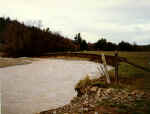 Eroding bank on Anderson Creek, tributary of the Navarro River, after the February 1986 flood event. Note the cut bank on the right. The creek is eroding valuable agricultural land. Photo taken 1986 by Chris Tebbutt.
Eroding bank on Anderson Creek, tributary of the Navarro River, after the February 1986 flood event. Note the cut bank on the right. The creek is eroding valuable agricultural land. Photo taken 1986 by Chris Tebbutt.
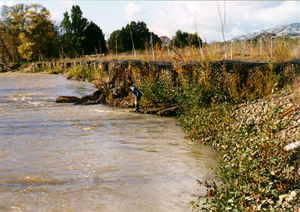 This is the same reach of Anderson Creek as shown above, in 1998, one year after treatment. Heavy netting was filled with rocks and surrounded with soil in which willows and alders were planted. As more sediment caught in the structures, more trees were planted. Photo by Chris Tebbutt.
This is the same reach of Anderson Creek as shown above, in 1998, one year after treatment. Heavy netting was filled with rocks and surrounded with soil in which willows and alders were planted. As more sediment caught in the structures, more trees were planted. Photo by Chris Tebbutt.
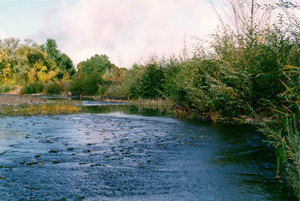 The photo at right is of the same location as the trees begin to mature. The bank is now completely protected and shade over the stream is developing. The newly recruited riparian also confines the stream course which will scour a deeper channel. Photo by Chris Tebbutt.
The photo at right is of the same location as the trees begin to mature. The bank is now completely protected and shade over the stream is developing. The newly recruited riparian also confines the stream course which will scour a deeper channel. Photo by Chris Tebbutt.
Riparian restoration can often be the most cost-effective means for restoring water quality in streams impacted by non-point source pollution (U.S. EPA,1996), and should always be considered when evaluating restoration options. Even in cases where riparian vegetation has been removed for decades and livestock grazing has compacted near-stream soil and caused dramatic down-cutting or widening of the stream channel, riparian restoration efforts have succeeded in reestablishing the structure and function of aquatic ecosystems (Platts, 1991).
 The critical step for any riparian restoration is the establishment of a riparian reserve or buffer strip (Kauffman et al. 1997). Riparian easements, grazing exclusion fences, and no-harvest corridors represent passive restoration which, due to natural revegetation, is often all that is necessary to reestablish riparian function.
The critical step for any riparian restoration is the establishment of a riparian reserve or buffer strip (Kauffman et al. 1997). Riparian easements, grazing exclusion fences, and no-harvest corridors represent passive restoration which, due to natural revegetation, is often all that is necessary to reestablish riparian function.
Bank stabilization efforts and planting, sometimes referred to as bio-engineering, are active restoration techniques which can effectively accelerate the natural recovery process. Active restoration is sometimes necessary due to exotic plants, erosive processes, or other factors. Many restoration efforts fail, however, due to the application of active techniques without the adequate protection of the riparian area (Kauffman et al 1997). While riparian restoration is often infeasible where sediment supply is excessively high, barren streamside zones can be re-vegetated in alluvial rivers if the design addresses geomorphic and fluvial processes, such as sediment transport and lateral migration.
The current emphasis in restoration of northern California streams has shifted from instream to upslope projects. This shift has been largely instituted by California's SB 271 which states that of the money allocated for salmon habitat restoration projects "at least 75 percent shall be used for watershed (upslope) and riparian area protection and restoration activities". Within this allocation, riparian projects may be under-funded due to lack of landowner support. Riparian restoration typically precludes normal land use in the reserve corridor. More effective incentives and educational outreach for landowners is required to enable an appropriate degree of riparian restoration for salmon recovery.
Riparian Restoration and Salmon Recovery
Riparian restoration will be an important component of salmon recovery, not only in agricultural and urban settings, but in both the headwater and lower river network portions of forested watersheds. Healthy riparian corridors are the key to restoring cool water temperatures where they formerly existed, and to providing large wood to the stream channel. A tremendous amount of discussion and controversy surrounds the prescription of riparian buffers on private industrial timber lands, particularly around smaller streams. Conservative buffer prescriptions preclude timber harvest from large portions of private land, but ensure the recruitment of large wood to the channel and increase the probability of restoring temperature and sediment regimes that provide for salmon habitat. Lower and mainstem sections of a river are some of the most important historic spawning and rearing areas for coho salmon (Beechie et al. 1994) and restoration of these components of the aquatic ecosystem will also require more extensive riparian restoration.
Active restoration or riparian areas may involve planting, riparian silviculture, and bio-engineering (Schiechtl and Stern 1996). Silvicultural techniques can be used to speed the succession of conifers and the consequent natural recruitment of long-lasting large wood to the stream, and may also be used to help eradicate non-native or undesirable species. Specific techniques are presented in the California Stream Habitat Restoration Manual (CDFG, 1998).
The following images are from Stream Corridor Restoration: Principles, Processes, and Practice (USDA 1996) and represent bank-stabilization techniques that promote the restoration of ecosystem function.
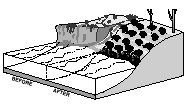 Bank Shaping and Planting
Bank Shaping and Planting
Re-grading streambanks to a stable slope, placing topsoil and other materials needed for sustaining plant growth, and selecting, installing and establishing appropriate species.
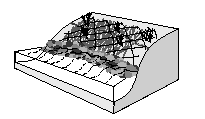
Brush Mattress
Combination of live stakes, live fascines, and branch cuttings installed to cover and physically protect streambanks, eventually to sprout and establish numerous individual plants.
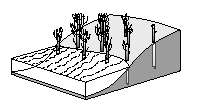 Dormant Post Plantings
Dormant Post Plantings
Planting of cottonwood, willow, poplar, or other species embedded vertically into streambanks to increase channel roughness, reduce flow velocities near the slope face, and trap sediment.
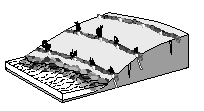 Live Fascines
Live Fascines
Dorman branch cuttings bound together into long sausage-like, cylindrical bundles and placed in shallow trenches on slopes to reduce erosion and shallow sliding.
References
Beechie, T., E. Beamer, and L. Wasserman. 1994. Estimating coho salmon rearing habitat and smolt production losses in a large river basin, and implications for habitat restoration. North American Journal of Fisheries Management 14: 797-811.
CA Department of Fish and Game. 1998 . California Salmonid Stream Habitat Restoration Manual. Third Edition. Inland Fisheries Division. California Department of Fish and Game. Sacramento, CA. 495 pp.
Gregory, S. V., F. J. Swanson, W. A. McKee, and K. W. Cummins. 1991. An ecosystem perspective of riparian zones. Bioscience 41(8):540-550.
Kauffman, J.B., R.L. Beschta, N. Otting, and D. Lytjen. 1997. An Ecological Perspective of Riparian and Stream Restoration in the Western United States. Fisheries 22(5):12-24.
Ligon, F., A. Rich, G. Rynearson, D. Thornburgh and W. Trush. 1999 . Report of the Scientific Review Panel on California Forest Practice Rules and Salmonid Habitat. Prepared for the California Resources Agency and the National Marine Fisheries Service, Sacramento, CA. 92 p plus appendices.
Perala, Christine. Personal communication. Phillip Williams and Associates. Portland, OR.
Platts, W. S. 1991. Livestock Grazing. American Fisheries Society Special Pub. 19:389-423.
Schiechtl, H.M., and R. Stern. 1996. Water Bioengineering Techniques for Watercourse Bank and Shoreline Protection. Blackwell Science.
USDA 1998 Stream Corridor Restoration: Principles, Processes, and Practice. Federal Interagency Stream Restoration Working Group.
U.S. EPA 1996 Ecological Restoration: A Tool to Manage Stream Quality. Environmental Protection Agency, Office of Water.
